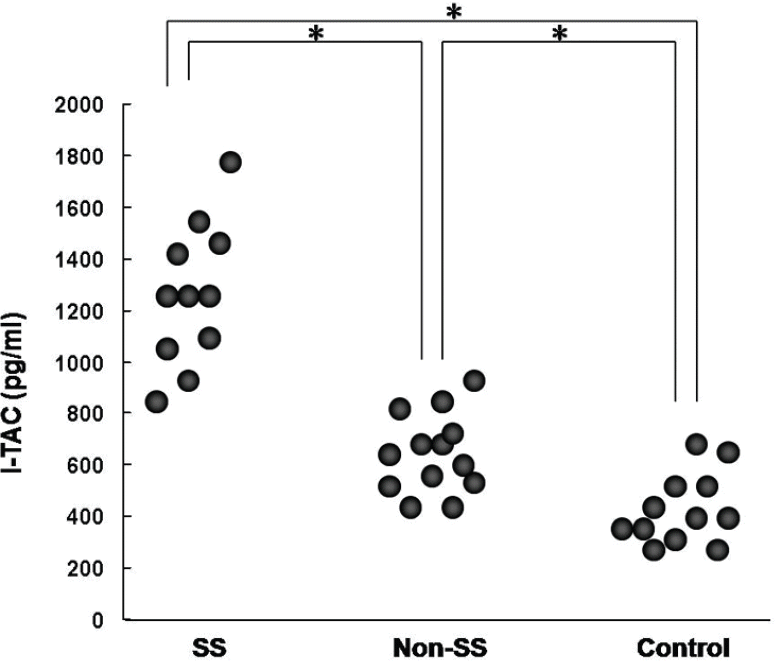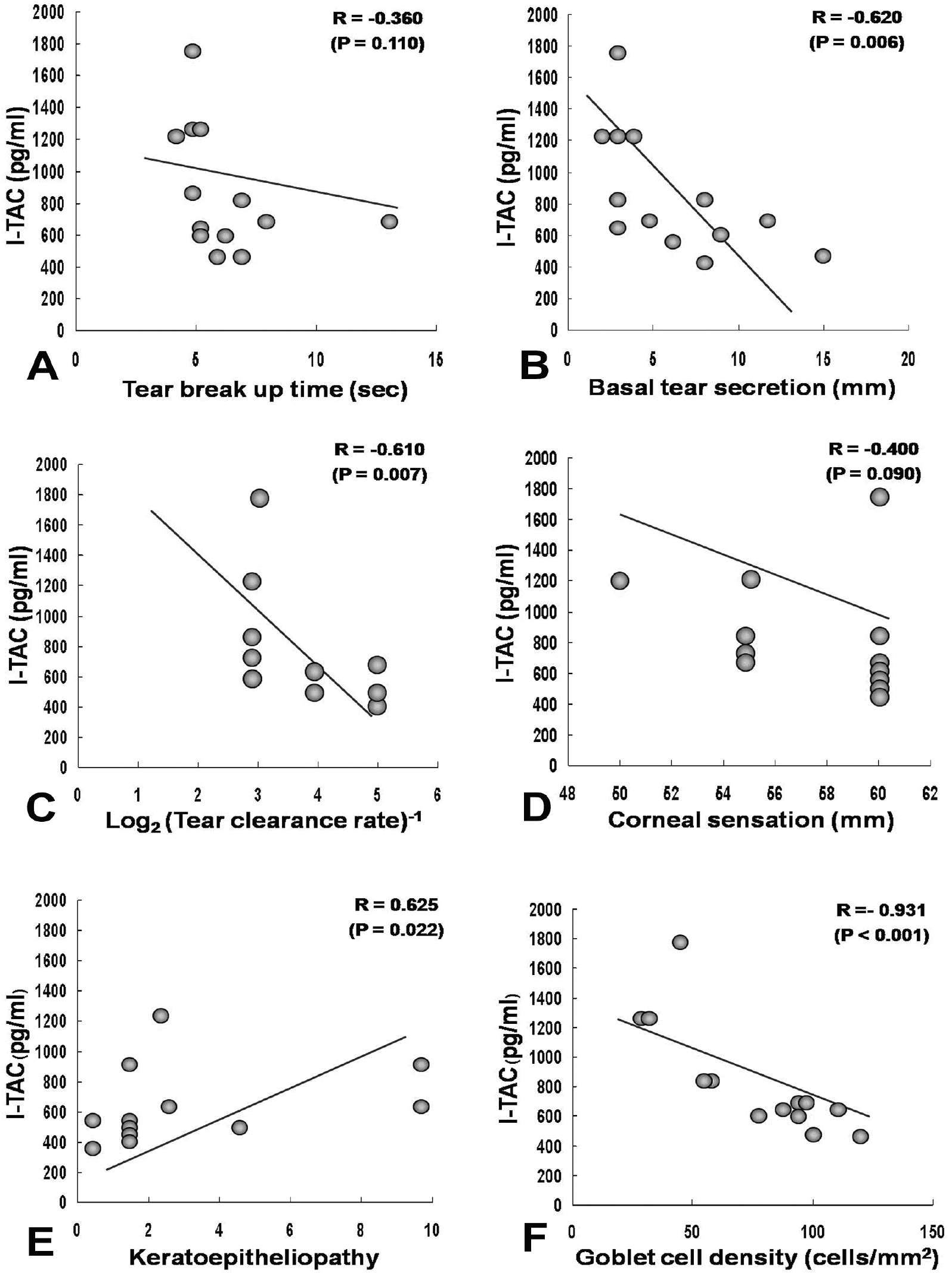Abstract
Purpose
This study was performed to evaluate the level of I-TAC in tears of patients with dry eye syndrome and its correlation with the tear surface parameters.
Methods
I-TAC levels were measured by enzyme-linked immunosorbent assay (ELISA) in tear samples collected from 33 dry eye patients (16 patients with Sjögren syndrome and 17 patients with non-Sjögren syndrome) and 15 control subjects. The correlations between I-TAC levels and tear surface parameters including tear film break-up time (BUT), basal tear secretion, tear clearance rate (TCR), corneal sensation, keratoepitheliopathy and conjunctival goblet cell density were analyzed.
Results
The mean levels of I-TAC were 717±377 pg/ml in patients with dry eye and 444±119 pg/ml in control subjects ( P=0.003). The mean levels in Sjögren syndrome patients (1261±324 pg/ml) were significantly higher than those of non-Sjögren syndrome patients (614±131 pg/ml, P=0.003). I-TAC levels correlated significantly with basal tear secretion ( P=0.006), TCR ( P=0.007), keratoepitheliopathy ( P=0.022) and goblet cell density ( P<0.001), but did not correlate with BUT ( P=0.110) and corneal sensation ( P=0.090).
Go to : 
References
2. Jones DT, Monroy D, Ji Z. . Sjögren's syndrome: cytokine and Epstein-Barr viral gene expression within the conjunctival epithelium. Invest Ophthalmol Vis Sci. 1994; 35:3493–504.
3. Pflugfelder SC, Jones D, Ji Z. . Altered cytokine balance in the tear fluid and conjunctiva of patients with Sjögren's syndrome keratoconjunctivitis sicca. Curr Eye Res. 1999; 19:201–11.

4. Stern ME, Gao J, Schwalb TA. . Conjunctival T-cell subpopulations in Sjögren's and non- Sjögren's patients with dry eye. Invest Ophthalmol Vis Sci. 2002; 43:2609–14.
5. Rolando M, Barabino S, Mingari C. . Distribution of conjunctival HLA-DR expression and the pathogenesis of damage in early dry eye. Cornea. 2005; 24:951–4.
6. Solomon A, Dursun D, Liu Z. . Pro- and anti-inflamma tory forms of interleukin-1 in the tear fluid and conjunctiva of patients with dry-eye disease. Invest Ophthalmol Vis Sci. 2001; 42:2283–92.
7. Afonso AA, Sobrin L, Monroy D. . Tear fluid gelatinase B activity correlates with IL-1alpha concentration and fluorescein clearance in ocular rosacea. Invest Ophthalmol Vis Sci. 1999; 40:2506–12.
8. Sobrin L, Liu Z, Monroy DC. . Regulation of MMP-9 activity in human tear fluid and corneal epithelial culture supernatant. Invest Ophthalmol Vis Sci. 2000; 41:1703–9.
9. Pflugfelder SC, Farley W, Luo L. . Matrix metallo proteinase-9 knockout confers resistance to corneal epithelial barrier disruption in experimental dry eye. Am J Pathol. 2005; 166:61–71.
10. Corrales RM, Stern ME. . Desiccating stress stimulates expression of matrix metalloproteinases by the corneal epithelium. Invest Ophthalmol Vis Sci. 2006; 47:3293–302.

11. Yeh S, Song XJ, Farley W. . Apoptosis of ocular surface cells in experimentally induced dry eye. Invest Ophthalmol Vis Sci. 2003; 44:124–9.

12. Li DQ, Chen Z, Song XJ. . Stimulation of matrix metalloproteinases by hyperosmolarity via a JNK pathway in human corneal epithelial cells. Invest Ophthalmol Vis Sic. 2004; 45:4302–11.

13. Li DQ, Luo L, Chen Z. . JNK and ERK MAP kinases mediate induction of IL-1, TNF-a and IL-8 following hyperosmolar stress in human limbal epithelial cells. Exp Eye Res. 2006; 82:588–96.
14. Luo L, Li DQ, Doshi A. . Experimental dry eye stimulates production of inflammatorycytokines and MMP-9 and activates MAPK signaling pathways on the ocular surface. Invest Ophthalmol Vis Sci. 2004; 45:4293–301.
15. De Paiva CS, Corrales RM, Villarreal AL. . Corticosteroid and doxycycline suppress MMP-9 and inflammatory cytokine expression, MAPK activation in the corneal epithelium in experimental dry eye. Exp Eye Res. 2006; 83:526–35.

16. Adhikary G, Crish J, Lass J, Eckert RL. Regulation of involucrin expression in normal human corneal epithelial cells: a role for activator protein one. Invest Ophthalmol Vis Sci. 2004; 45:1080–7.

17. Pflugfelder SC, Jones D, Ji Z. . Altered cytokine balance in the tear fluid and conjunctiva of patients with Sjögren's syndrome keratoconjunctivitis sicca. Curr Eye Res. 1999; 19:201–11.

18. Rolando M, Barabino S, Mingari C. . Distribution of conjunctival HLA-DR expression and the pathogenesis of damage in early dry eye. Cornea. 2005; 24:951–4.
19. Jones DT, Ji Z, Monroy D. Pflugfelder SC. Alterations of ocular surface gene expression in Sjögren's syndrome. Adv Exp Med Biol. 1998; 438:533–6.
20. Luo L, Li DQ, Doshi A. . Experimental dry eye stimulates production of inflammatory cytokines and MMP-9 and activates MAPK signaling pathways on the ocular surface. Invest Ophthalmol Vis Sci. 2004; 45:4293–301.

21. Yoon KC, De Paiva CS, Qi H. . Expression of Th-1 chemokines and chemokine receptors on the ocular surface of C57BL/6 mice: effects of desiccating stress. Invest Ophthalmol Vis Sci. 2007; 48:2561–9.

22. De Paiva CS, Villareal AL, Corrales RM. . Dry eye-induced conjunctival epithelial squamous metaplasia is modulated interferone-gamma. Invest Ophthalmol Vis Sci. 2007; 48:2553–60.
23. Vitali C, Bombardieri S, Jonsson R. . European Study Group on Classification Criteria for Sjögren's Syndrome. Classification criteria for Sjögren's syndrome: a revised version of the European criteria proposed by the American-European Consensus Group. Ann Rheum Dis. 2002; 61:554–8.
24. Sallusto F, Lenig D, Mackay CR, Lanzavecchia A. Flexible programs of chemokine receptor expression on human polarized T helper 1 and 2 lymphocytes. J Exp Med. 1998; 187:875–83.

25. McInnis KA, Britain A, Lausch RN, Oakes JE. Human corneal epithelial cells synthesize ELR(-)alpha-chemokines in response to proinflammatory mediators. Ocul Immunol Inflamm. 2007; 15:295–302.
26. Cole KE, Strick CA, Paradis TJ. . Interferon-inducible T cell alpha chemoattractant (I-TAC): a novel non-ELR CXC chemokine with potent activity on activated T cells through selective high affinity binding to CXCR3. J Exp Med 19. 2009-21; 98:15–187.

27. Colvin RA, Campanella GS, Sun J, Luster AD. Intracellular domains of CXCR3 that mediate CXCL9, CXCL10, and CXCL11 function. J Biol Chem. 2004; 279:30219–27.

28. Sauty A, Colvin RA, Wagner L. . CXCR3 internalization following T cell-endothelial cell contact: preferential role of IFN-inducible T cell alpha chemoattractant (CXCL11). J Immunol. 2001; 167:7084–93.
29. Gulati A, Sacchetti M, Bonini S, Dana R. Chemokine receptor CCR5 expression in conjunctival epithelium of patients with dry eye syndrome. Arch Ophthalmol. 2006; 124:710–6.

30. Ogawa N, Kawanami T, Shimoyama K. . Expression of interferon-inducible T cell alpha chemoattractant (CXCL11) in the salivary glands of patients with Sjögren's syndrome. Clin Immunol. 2004; 112:235–8.
31. Petkovic V, Moghini C, Paoletti S. . I-TAC/CXCL11 is a natural antagonist for CCR5. J Leukoc Biol. 2004; 76:701–8.

32. Stern ME, Beuerman RW, Fox RI. . The pathology of dry eye: the interaction between the ocular surface and lacrimal glands. Cornea. 1998; 17:584–9.
Go to : 
 | Figure 1.I-TAC levels in tears of Sjögren syndrome patients, non-Sjögren syndrome patients and control subjects. SS=Sjögren syndrome; Non-SS=Non-Sjögren syndrome;* p<0.05. |
 | Figure 2.Correlation between I-TAC levels in tears of dry eye patients and tear surface parameters including tear break up time (A), basal tear secretion (B), tear clearance rate (C), corneal sensation (D), keratoepitheliopathy score (E) and conjunctival goblet cell density (F). |
Table 1.
Comparison of tear film parameters in dry eye patients with and without Sjögren syndrome and control subjects
|
DES |
||||
|---|---|---|---|---|
| SS | Non-SS | Controls | ||
| BUT (sec) | 5.82±2.10* | 13.40±2.41 | ||
| 4.63±0.92*† | 6.64±2.34* | |||
| BST (mm) | 5.15±2.96* | 12.40±2.99 | ||
| 3.13±0.64*† | 7.63±3.47* | |||
| Log2 TCR | 3.46±0.94* | 4.70±6.75 | ||
| 3.13±0.83* | 3.91±0.83* | |||
| CST (mm) | 57.12±3.35 | 58.50±2.42 | ||
| 55.0±4.63* | 57.73±2.61 | |||
| Keratoepitheliopathy | 2.97±2.87* | 0.10±0.32 | ||
| 5.50±3.42*† | 1.45±1.37* | |||
| GCD (cells/mm2) | 73.30±32.61* | 207.00±30.74 | ||
| 38.4±11.19*† | 95.12±18.36* | |||




 PDF
PDF ePub
ePub Citation
Citation Print
Print


 XML Download
XML Download